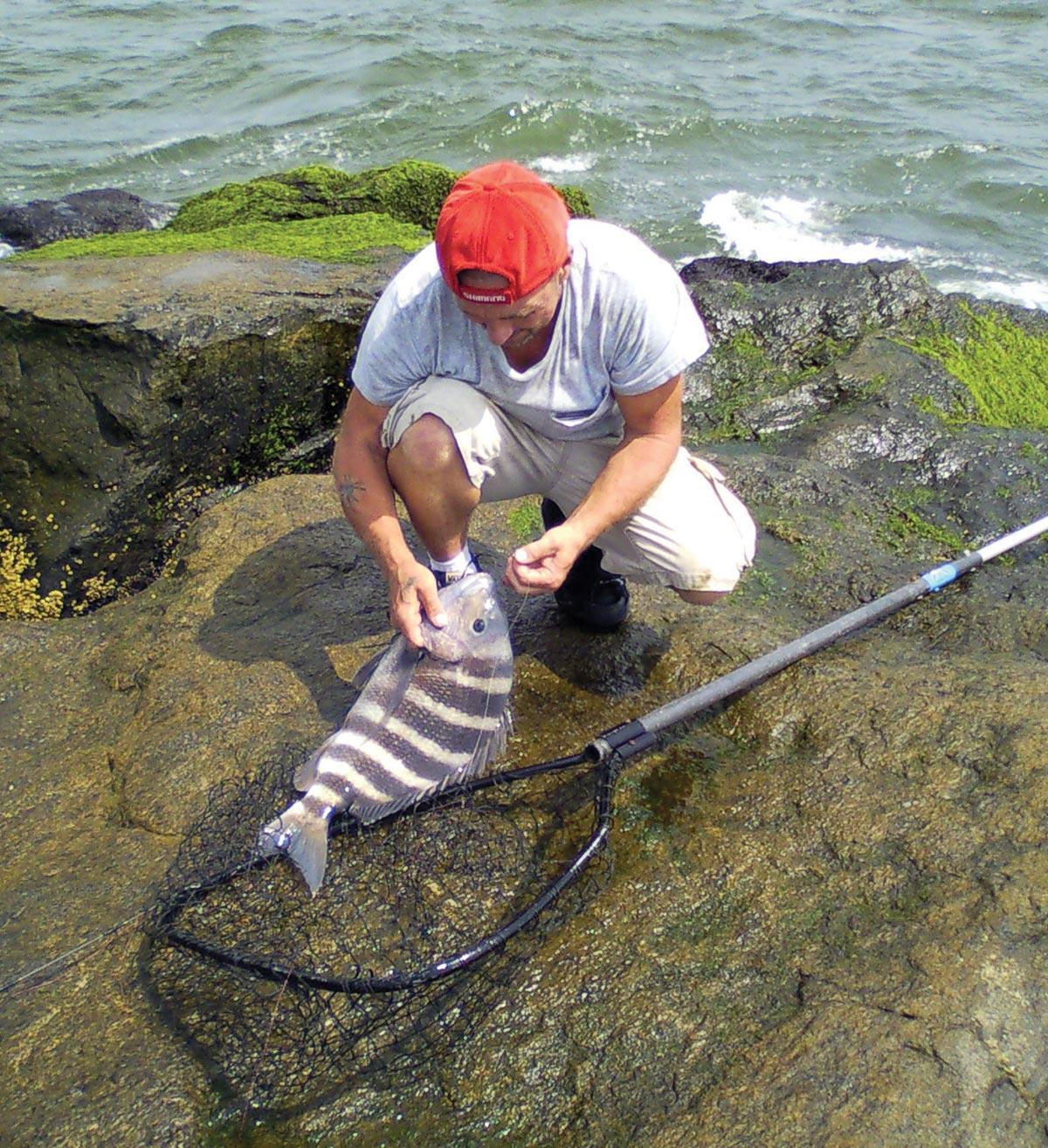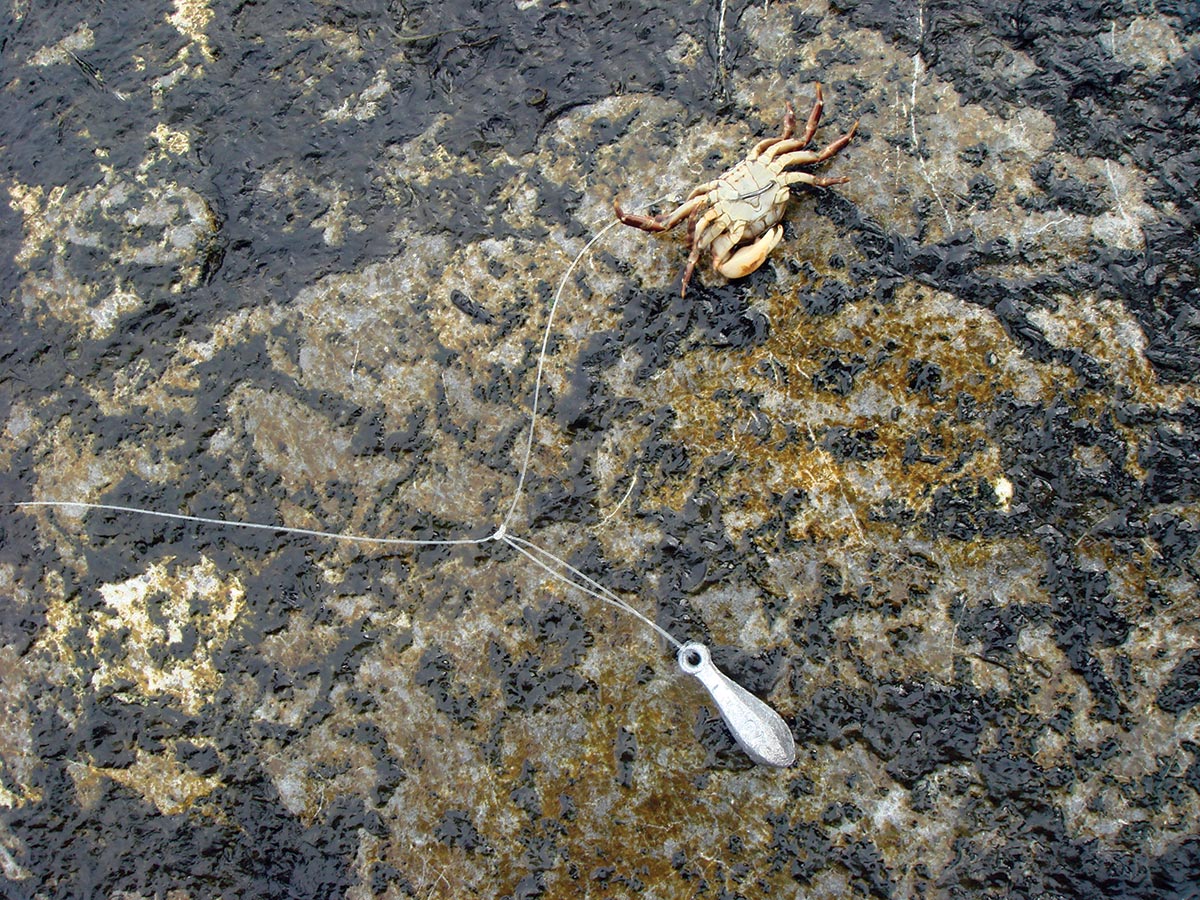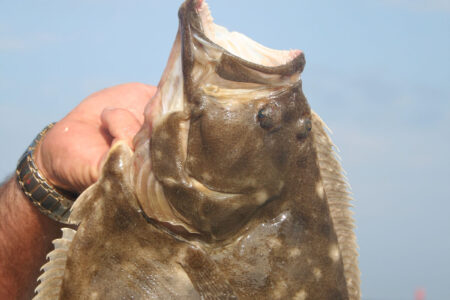
A good season of black drum action could be a great sign for sheepshead to come!
Here in the northeast, where weather changes from season to season like the colors of a chameleon, there has been a change in the making; warmer water temperatures have brought about new fishing opportunities, and the sheepshead is slowly joining the group of “northeast nomads.”
Sheepshead look very much like a black drum (especially like the smaller “puppy” drum with vertical stripes), with a few distinguishing features that separate the two, the large protruding teeth probably the main way to identify sheepshead from black drum. I have seen folks toss a sheepshead back into the sea, thinking they were small black drum. This could very well be the reason that few large sheepshead see the hooks of a scale. As time goes on perhaps and more fish are caught, sharp anglers are getting smart to the existence of the sheepshead in our northeast waters.
The sheepshead is a staple of southern fishing communities where they are targeted and eaten in states like Florida and Louisiana. The sheepshead is in fact a great eating fish. I find that most fish that are crustacean feeders are quite tasty; the food a fish eats most certainly reflects the taste of the meat, and sheepshead, triggerfish and tog are some of the crab-eating species that are consistently targeted by “connoisseurs of the fry pan.”
Bigger is Better
Locally, sheepshead have mostly been caught by accident by jetty jumpers and bridge huggers alike. But with the numbers growing rapidly, sheepshead are actually starting to be targeted by some of the craftier anglers out there.
I have caught a fair amount of sheepshead off of the jetties at the New Jersey coast, and the areas from Barnegat Light to Cape May have been a virtual hot bed for big fish in the past six or seven summers. The six fish I have had the privilege of catching all broke the 10-pound mark. The current New Jersey state record – a 19-pound, 3-ounce specimen – was caught in 2014 by William Catino at Longport, while Delaware’s state record of 17 pounds, 2 ounces was caught that same year by Pennsylvania’s Dave Walker while fishing Delaware Bay.
In the grand scheme of things, we’re not far from international acclaim, as the world record of 21 pounds, 4 ounces caught off of the southern coast of Louisiana by Wayne Desselle in 1982 is not too far out of reach.

The fish we are seeing up here in the northeast are wanderers, and the more food they find – as a general rule – the bigger they are going to get. Our local grounds provide a virtual smorgasbord for these fish, with green crabs and other species of crustaceans in full natural supply. Will they set up shop here? With food availability and water temperatures rising like never before, the sheepshead may very well be here to stay, in the comfortable structure and crab-packed waters of the northeast.
Sheepshead, much like triggerfish and tautog, are strictly crustacean feeders. Though I have actually caught a sheepshead on a jig tipped with Fin-S, crabs and shrimp are on top of the sheepshead’s list of food stuff. Warm water is the other draw for these mysterious nomads, and for most local anglers structure is a major piece to the sheepshead puzzle. They absolutely love rock piles and other structure such as sunken boats and wrecks, though they are rarely caught in deeper water offshore, undoubtedly due to the lower bottom temps in deeper water. Florida boaters have long been catching sheepshead off of structure far off Florida’s coast, but down there the water stays warm on offshore structure.
Food availability may also provide a logical explanation as to why the northeast sheepshead stays inshore; and the Asian shore crab may be the key. The Asian crab has been on the jetties of New Jersey and New York since 1988 when it was documented by biology professor John McDermott of Franklin-Marshall College of Pennsylvania while on a field trip with students in Townsend’s Inlet in South Jersey. It is suspected that the crab – which was not indigenous to the United States – made its way here through the bilge systems of ships, and then from there to the northeast corner of our country via similar means. I have cleaned bilge systems in bait and tackle shops in New Jersey in the spring, and the water flow pipes for the bait tanks are all but clogged with wintering Asian crabs that climbed all the way up into the system looking to hibernate as waters cooled.
I have corresponded with professor McDermott over the years on the issue of the shore crab coupled with the arrival of species like sheepshead, triggerfish and other formerly tropical species, and he, like myself acknowledges some sort of connection. However, green crabs and large shrimp, or even shedder crabs, if caught and used alive will work just as well to attract a bruiser sheepshead to your line. I know some sharp anglers who have been catching sheepshead on fresh, store bought shrimp, smartly tossing out a clean, clearly visible bait that most sheepshead have probably eaten in the past, somewhere along their travels. With climate changing like it has in the past 10 to 15 years, it looks as though these formerly elusive fish will summer here more and more providing an outstanding new target for local anglers.
Think Summer
The eight sheepshead that my son and I managed to land since 2005 were caught on adrenaline and opportunity; we continually fish jetties for tautog, our favorite eating fish. Of the 40 to 50 trips we would take for tog on the rocks each summer, we may take one or two sheepshead; we have lost another four or five fish on the sharp structure, or because we were simply off of our game on that day. Shore crabs are the bait of choice; I believe that they are the natural bait to the sheepshead, up here in the north anyway, and we try to “match the hatch” in all of our fishing endeavors.
When trying to target and catch sheepshead, think summer; the fish love warm water, and August and the first two weeks of September have typically been when the most sheepshead catches are reported in New Jersey. Depending on the weather patterns for that particular year, you can actually catch fish in July and through September into October; but again, this is during a year when things warm up quickly and stay warmer longer into the season.

I prefer to start in mid-July and go through September, optimizing my chances by simply being where sheepshead may be grazing, which is as many of the summer days as is possible. Your gear can be light, as I have caught sheepshead on light tackle; but it should be good equipment. I find 50-pound braid most comfortable to me; I rarely down size, as structure is unforgiving and losing a fish on a sharp rock is certainly an issue. Rods can be short, as short as 7 feet, but should be stout; I like a heavy action rod with some sensitivity, like a St. Croix Avid or a G-Loomis GL-series. Since I use only Shimano reels, a Stradic 4000 is my choice reel, as it has a fool-proof drag system and will give you less chance of “technical difficulties.”
Rigs don’t have to be anything that hasn’t been used before; we catch most of our sheepshead on a dropper loop with light sinkers, some as light as 1-ounce, fishing in 30 feet or more of current laden waters. Feeling for bottom and making sure that you are down deep is essential; if you have to up your weight because of the thickness of your line, it’s best to do so. The leaders are 50-pound fluorocarbon at the very least; going bigger, perhaps 60-pound test will ensure a solid hook-up, and give you some more confidence that you won’t be standing there with a frayed leader and a lost fish.
To put it simply, the same rigs used for blackfish can be effective for catching sheepshead, though my first fish, a bruiser at just over 15 pounds, (and an unofficial state record at the time) actually took a Fin-S intended for weakfish. Mostly though, we will go and catch a bucket of Asian crabs and use the largest of the bunch, which typically are about the size of a quarter or as big as a half dollar. Tides should be running out, and we never fish the “dirty water low,” which is when the tide gets so low that silt from the bottom begins to cloud the water. This cuts your chances in half as sheepshead, like many other fish rely on sight as well as smell.
When you hook into a big sheepshead on the structure, you will know it. They don’t head for a rocky lair like a tog, and they’re certainly far more squirrelly than a triggerfish; they will use the current to their advantage, their thick, powerful bodies running back and forth, and once you see that you have a sheepshead on, you can only hope that it doesn’t see you first, or the fight is on again! The sheepshead is like a bluefish; it doesn’t tire, and it doesn’t run out of fight. You will have your hands full right up until the moment that you get it into the net, which you will certainly need to have on hand.
Now that the sheepshead numbers are actually big enough to target them as a trophy fish, go out and give it a try. Find a bridge or jetty, and be persistent; but hold on to that rod, and lastly, make sure that your drag is set just right; you may just be the new state record holder in your stomping grounds!
| ON THE HOOK |
|---|
| Boaters are now on the sheepshead wagon train; they will anchor or drift under bridges and toss crab baits onto the abutments; this is how a lot of big fish got a ride on the scales in recent years. In fact, the previous state record sheepshead of 17 pounds, 3 ounces was taken by Manahawkin’s Paul Lowe while bottom fishing with clams near the Causeway Bridge. And then there’s Capt. Dan Shafer of Insomniac Guide Service out of Stone Harbor who may already be putting his crab-tipped Bottom Sweeper jigs to the test right now for a couple of Cape May County sheepshead. Again, same as you’d target the tog – vertical crab jigging the structure for example – you can target the sheeps. |




